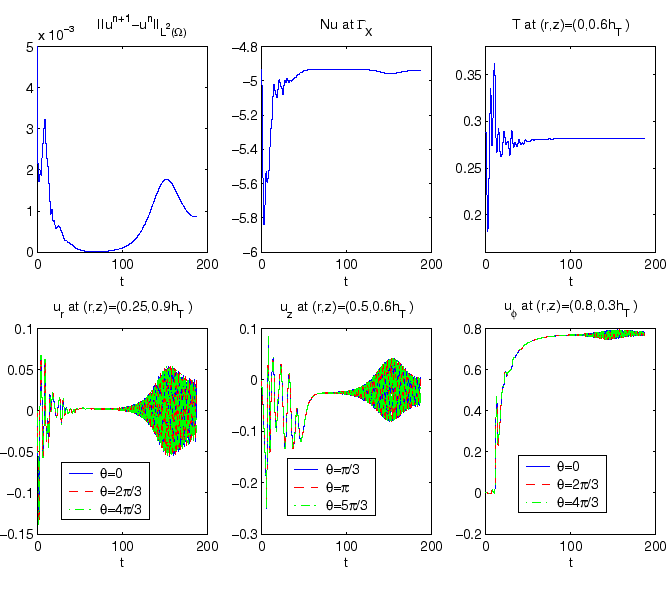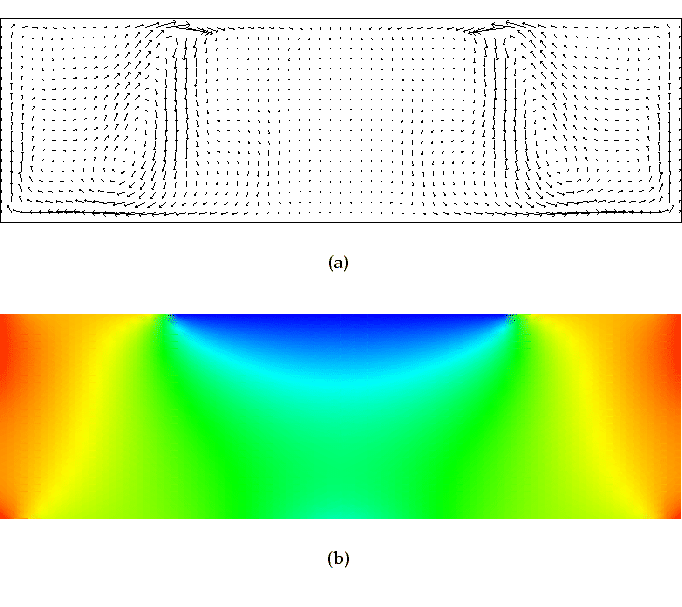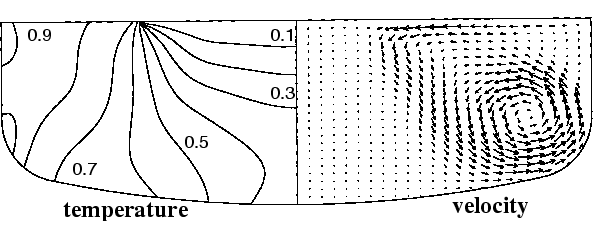|
|
|
[Contents] | [Index] |
Cooperation with: K. Böttcher, W. Miller, U. Rehse (Institut für Kristallzüchtung (IKZ) Berlin)
Description: As a result of recent semiconductor technology, there is currently much interest in the growth of high-quality indium phosphide (InP) crystals. This is especially true in the fields of optoelectronics and radio frequency electronics. There it is known, for example, that InP-based electronic components can perform much more efficiently than the hitherto favored gallium arsenide (GaAs) or silicon, mainly because InP can operate at higher frequencies.
Since May 2003 we have been engaged in a collaborative project with the Institute
for Crystal Growth (IKZ) in Berlin, which has involved comparison of 2D and 3D
numerical transient-flow simulations performed with different solvers at each
institute, as a precursor to experimental growth using the
vapor-pressure-controlled Czochralski (VCz) equipment at IKZ
(http://www.ikz-berlin.de/groups/ag.czhl/pview.php?lang=EN&opt=0&no=07).
This method of growth is a variant on the liquid-encapsulated Czochralski (LEC)
growth method; an important additional feature of the VCz method is that
the crystal, melt, and encapsulant are placed in an insulated inner chamber,
which can significantly reduce potentially damaging thermal stresses within
the grown crystal. We have previously applied the method to modeling the growth of
GaAs crystals, as documented in last year's report [1]. Subsequent
results can be found in [2], [3]. A similar model to the one described
therein can be applied to InP growth, i.e. the liquid mechanics are again
described by a coupled thermo-hydrodynamic system comprising the
incompressible Navier-Stokes equations and the heat-transport equation.
A fundamental difference applies to
the boundary conditions for temperature,
specifically on the encapsulant/melt interface ![]() and the crucible
wall
and the crucible
wall ![]() . For the InP study, we have applied a Dirichlet condition on both
boundary sections, based on advection-free global simulation data supplied by
IKZ. This contrasts with the more simplified conditions of adiabaticity on
. For the InP study, we have applied a Dirichlet condition on both
boundary sections, based on advection-free global simulation data supplied by
IKZ. This contrasts with the more simplified conditions of adiabaticity on
![]() and Dirichlet value dependence derived from simple functions on
and Dirichlet value dependence derived from simple functions on
![]() , as assumed for the GaAs study.
, as assumed for the GaAs study.
|
In our mathematical model, the flow variables are non-dimensionalized in a standard
fashion, mainly using the crucible radius RC (as characteristic length), the
melt kinematic viscosity ![]() , the melt density
, the melt density ![]() , the temperature difference
, the temperature difference
![]() T between the crystal/melt interface
T between the crystal/melt interface ![]() and the rim of the
crucible, and the angular velocities of the
crystal and crucible (
and the rim of the
crucible, and the angular velocities of the
crystal and crucible (![]() and
and ![]() , in turn). Industry-relevant
values of these quantities are shown in Table 1 above, as well as the Prandtl
number Pr and thermal Rossby (or Richardson) number Ro. Finally, a non-dimensional
crystal radius rX = 0.5 and a non-dimensional height hT = 0.6 were chosen.
As with the GaAs project, we have performed computations using both
cylindrical and realistic geometry. Also our initial efforts have been directed
towards the case of iso-rotation, with
, in turn). Industry-relevant
values of these quantities are shown in Table 1 above, as well as the Prandtl
number Pr and thermal Rossby (or Richardson) number Ro. Finally, a non-dimensional
crystal radius rX = 0.5 and a non-dimensional height hT = 0.6 were chosen.
As with the GaAs project, we have performed computations using both
cylindrical and realistic geometry. Also our initial efforts have been directed
towards the case of iso-rotation, with
![]() =
= ![]() , and
this holds for the examples shown below. The Reynolds number is
appropriately defined as:
Re =
, and
this holds for the examples shown below. The Reynolds number is
appropriately defined as:
Re = ![]() RC2/
RC2/![]() .
.
First, in the case of cylindrical geometry, we have performed axisymmetric, and
more recently, three-dimensional (3D) melt-flow simulations for Reynolds numbers
ranging from 1000 to 8000, all with
Ro = 1 , Pr = 0.015. Although
these values are typically well below those required by industry (whose
values lie inside the turbulent regime), the rich structure in the resultant
flow behavior seems worthy of analysis in its own right. Moreover, it provides
a good basis for comparing results obtained with our finite element solver NAVIER,
and those provided by STHAMAS3D, a finite-volume code with upwinding implemented
at IKZ. The latter is more dissipative
than ours and may be better suited to computing flow properties more relevant
to industry, especially time-averaged quantities such as crystal/melt
interface shape, and mean frequencies. On the other hand,
NAVIER seems to be
better suited to capturing transient effects accurately.
As in the case for the GaAs research,
the steady axisymmetric state was found to be most unstable to
3D oscillatory instabilities; for iso-rotation with
![]() =
= ![]() for example, we have found that,
while the 2D solver first exhibits transient behavior for
Re
for example, we have found that,
while the 2D solver first exhibits transient behavior for
Re ![]() 4500
(corresponding to 1.18 rpm), in the 3D simulation this value is just below
3000 (around 0.79 rpm).
4500
(corresponding to 1.18 rpm), in the 3D simulation this value is just below
3000 (around 0.79 rpm).
 |
In fig1_vcz.eps, we can see the time history plots for a selection of point data, as well as the Nusselt number on the crystal/melt interface and the mean difference between successive solutions; the relatively long ``swing-in'' phase which precedes oscillatory motion may suggest nearness to the critical Reynolds number. It is also noticeable from these plots that the high frequencies at this stage are purely associated with the three-dimensionality, with two-dimensional frequencies being very short, in comparison.
fig2_vcz.eps depicts the time-averaged flow and temperature profiles in an (almost) arbitrary vertical plane passing through the crucible and containing the axis. Here the time averaging was based on using a non-dimensionalized end time of 200 (or equivalently, running for 31.8 revolutions in dimensional terms). In fact, this solution is very similar to the axisymmetric component of the flow and reinforces the point regarding the relatively weak three-dimensional presence. Examination of the Fourier angle modes for various flow quantities reveals that the mode with azimuthal wavenumber 4 is the dominant 3D mode, although this is virtually indiscernible from cross-sectional slices of the crucible, so dominant is the axisymmetry. Another conclusion is that the flow is dominantly rotational with buoyancy playing a minor rôle here; the strongest non-rotational influence appears to stem from the large temperature gradient near the crystal/melt/encapsulant triple line (annulus).
 |
We have also recently applied our axisymmetric solver to simulating melt flows in crucibles of a more realistic design. The geometry here principally consists of a cylindrical flat-topped rim section joined to a spherical section, which itself is joined to a spherical cap of relatively large radius. Although similar qualitative features are found in comparison with using cylindrical geometry, early indications suggest that the former type is more de-stabilizing. In fig3_vcz.eps, for example, the solution is presented for Pr = 0.015 , Ro = 1, and Re = 3500 (0.92 rpm, approx.) portraying the time-averaged temperature and projected-velocity fields, based on a dimensionless end time of 100 (15.9 revolutions).
 |
In conclusion then, we have computed axisymmetric and 3D steady/transient
melt-flow solutions for crucibles with cylindrical geometry, and axisymmetric
steady/transient solutions using realistic geometry.
In general, all of the results tend to suggest that, for Reynolds numbers up to
8000 at least, the flow is dominantly rotational, with the strongest
non-rotational influence stemming from the triple line.
For future work, we are principally interested in
simulating transient 3D solutions using realistic geometry
(in parallel with IKZ). Before this however, a realistic design of the meniscus
at the triple line will be added, and suitable 3D meshes constructed.
References:
|
|
|
[Contents] | [Index] |